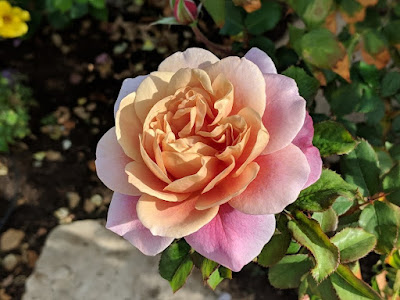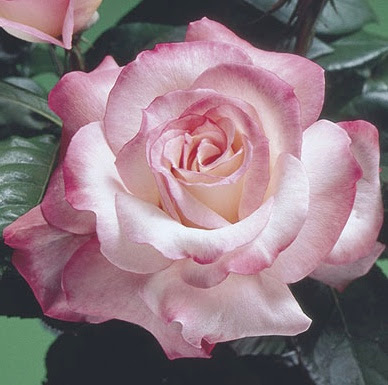
Master rosarian offers her suggestions, shares tips with Farmer Fred

|
|
"Distant Drums" is a winner in Sacramento, says
master rosarian Charlotte Owendyk. (Photos courtesy
Charlotte Owendyk) |
January is the perfect time for pruning roses. It’s also a great opportunity to plant roses.
But which one? There are so many, many rose varieties – more than 30,000 still available in commerce. Is there a “best rose” for Sacramento? For America?
"Farmer Fred" Hoffman, longtime Sacramento gardening expert, posed those questions to Roseville master rosarian Charlotte Owendyk during his latest “Garden Basics with Farmer Fred” podcast. Owendyk, who grows hundreds of roses in her own garden, is well known for her pruning demonstrations and rose talks. During the podcast, she covered some of the pruning pointers from the Sierra Foothills Rose Society’s recent winter rose care workshop.
As for the subject of “best rose,” it depends on who’s growing it and where. Charlotte shared her favorite “bulletproof roses,” varieties that bloom beautifully under a wide range of growing conditions and circumstances – cold winters, hot summers and everything in between.
Her adaptable favorite is an oldie but goody that’s hard to find: 'Distant Drums." Introduced in 1985, it’s a shrub rose with 4-inch blooms that blend orange and purple tones like a Western sunset.
“One rose that can really take the heat and the cold is ‘Distant Drums,’ which has a very distinct coloration,” she says. “The petals are apricot-colored in the center, surrounded by lavender on the outer petals. It’s hardy down to USDA Zone 4, and has a wonderful strong scent with great disease resistance.”
Zone 4 gets down to 0 degrees (or colder); that’s tough!
Her bulletproof floribundas include two old stand-bys: "Iceberg" and "Burgundy Iceberg." They both do well almost anywhere and are a lot easier to find than "Distant Drums." Introduced in 1958, "Iceberg" is ubiquitous in California parking lots; it’s a white rose that can take pollution and still look good. "Burgundy Iceberg" is a purple version of its close cousin.

|
|
"Secret" is a frequent bloomer and very fragrant.
|
“Normally, hybrid tea roses take five or six weeks to rebloom after deadheading,” she says. “For ‘Secret,’ it’s only four to five weeks. That’s why it’s one of my favorite roses. Plus it’s very fragrant.”
Other roses on Charlotte’s bulletproof list include the shrub roses Belinda’s Dream, Lyda Rose and Sally Holmes (which can also be grown as a climber), the floribunda Cinco de Mayo and the hybrid teas Gemini and Memorial Day.
Hear more here: https://gardenbasics.substack.com/p/the-best-roses-for-america-one-master
Also, listen to Fred and Charlotte talk winter rose care during their full podcast, “Prune-ciples: Rose Pruning Tips for Maximum Roses,” at https://www.buzzsprout.com/1004629 .
At that link, you’ll find a full library of Farmer Fred podcasts.
Rather read than listen? Sign up for Farmer Fred’s Garden Basics newsletter: https://gardenbasics.substack.com/ .
Comments
0 comments have been posted.Sacramento Digs Gardening to your inbox.
Sites We Like
Garden Checklist for week of May 5
Survey your garden after the May 4 rainstorm. Heavy rain and gusty winds can break the neck of large flowers such as roses. Also:
* Keep an eye on new transplants or seedlings; they could take a pounding from the rain.
* Watch out for powdery mildew. Warmth following moist conditions can cause this fungal disease to “bloom,” too. If you see a leaf that looks like it’s dusted with powdered sugar, snip it off.
* After the storm, start setting out tomato transplants, but wait on the peppers and eggplants (they want warmer nights). Pinch off any flowers on new transplants to make them concentrate on establishing roots instead of setting premature fruit.
* Trim dead flowers but not leaves from spring-flowering bulbs such as daffodils and tulips. Those leaves gather energy to create next year's flowers. Also, give the bulbs a fertilizer boost after bloom.
* Pinch chrysanthemums back to 12 inches for fall flowers. Cut old stems to the ground.
* Mulch around plants to conserve moisture and control weeds.
* From seed, plant beans, beets, cantaloupes, carrots, corn, cucumbers, melons, pumpkins, radishes and squash.
* Plant onion sets.
* In the flower garden, plant seeds for asters, cosmos, celosia, marigolds, salvia, sunflowers and zinnias. Transplant petunias, zinnias, geraniums and other summer bloomers.
* Plant perennials and dahlia tubers for summer bloom.
* Don’t wait; plant summer bulbs, such as gladiolus and tuberous begonias.
* Harvest cabbage, lettuce, peas and green onions.